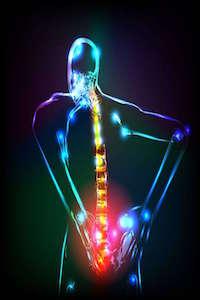for Over 25 Years
What is Radiculopathy as it Relates to Spinal Cord Injuries Sustained in Car Accidents?

What is radiculopathy as it related to spinal cord injuries sustained in car accidents? Spine injuries are one of the most serious injuries one could sustain as a result of an auto accident. The term radiculopathy is defined by medical dictionaries as follows: “Injury to a spinal nerve root so that pain radiates from the root along the course of the damaged nerve.” In laymen’s terms it is pain which travels down the nerve and, oftentimes, into other parts of the body including the extremities like the arms and legs.
What Causes Nerve Impingement After a Auto Accident?
The most common cause of nerve damage after an automobile accident is a herniation (or bulging) of the discs that lie between the vertabrae. When the nerves in and around the spinal cord are impacted by one of these discs, they send pain signals along the path of the nerve. If the nerve is impacted at the cervical (neck) or thoracic (mid-back) level, this pain can travel through the neck, shoulders and arms. If the impinged nerve root in the lower back (lumbar region), the pain can travel down the buttocks and legs along the sciatic nerve (so called “sciatica”) or even headaches and other neurological symptoms. These conditions can result in shooting pains, aches, numbness and, at worst, loss of mobility and function (either partial or full paralysis).
What are Some of the More Common Types of Radiating Pain Related to Auto Accident Injuries?
The trauma of an traffic collision is the main culprit in a damaged nervous system causing this type of radiating pain. This can include the following:
- Rear End Collisions: The dynamics of a rear end collision especially at high impact can cause both concussions and also herniations in the discs of the cervical and thoracic spine. If a seatbelt or other restraint is in place and functioning, this can reduce the level of trauma but, the injury sustained even in a lower impact collision can be significant depending upon any number of factors including the angle of the crash, whether the vehicle struck was stopped or moving, impact with fixed objects within the car and many other circumstances. Although less frequent, lumbar herniations can also be caused by being impacted from behind. In the case of a cervical strain (commonly known as “whiplash”), the symptoms of radiating pain usually subside within a fairly short time frame (weeks to months). However, one recent Swedish study found that persons sustaining a whiplash injury due to a rear impact accident are more likely to have continued pain and health problems up to seven years after the incident.
- Side Impact and Roll Over Car Crashes: Persons involved in side impact car wrecks are also at high risk for the type of trauma that would cause spinal cord and nerve damage. Again this depends upon a number of factors including speeed, angle of impact, whether the vehicle is completely rolled over and other matters. However, side impact and roll over smash ups tend to cause the body and the spine in particular to move in odd directions causing the vertebrae to be jostled out of place.
What are Some of the Common Treatments for Nerve Damage Causing Radiating Pain?
Typically, these types of injuries are treated in one or more of the following ways: (1) pain medications including muscle relaxants; (2) epidural or trigger point steroidal injections that are meant to shrink the bulging discs; (3) Physical therapy including massage, physiotherapy, electrical stimulation, and other related therapies; and / or (4) Surgery. Depending Upon the severity of the injury, most orthopedic doctors usually try the most “conservative” approach first (i.e. pain medications in conjunction with physical therapy).
Why is it Important to Seek Out Prompt Medical and Legal Assistance if You Suffer From Radiating Pain After a Car Accident?
This type of injury can be treated and resolve but, it can also linger for years. The extent of the damage to the nerves needs to be ascertained as quickly as possible and the healing process needs to be closely monitored by a competent medical professional. Diagnostic studies like MRIs are usually the best way to determine nerve impingement issues as these cannot be fully ascertained by x-rays. Nerve conduction tests are also often helpful in making the diagnosis as to severity.
Once you have signed a settlement and release of claims with an auto insurance carrier, this is a settlement of both present and future claims of any type. Therefore, it is important to have a competent personal injury attorney coordinate with the treating doctors to understand the extent of the injury and the long term prognosis for any lasting effects so that this can be factored into the value of the claim and any potential settlements.












